













|
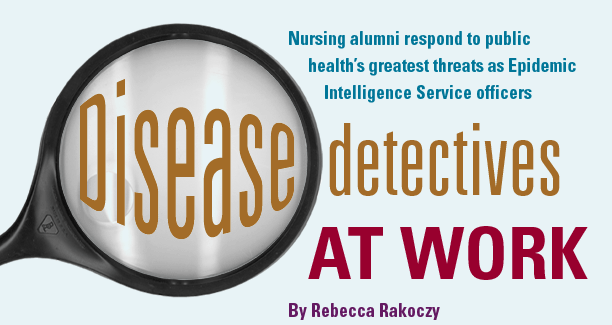
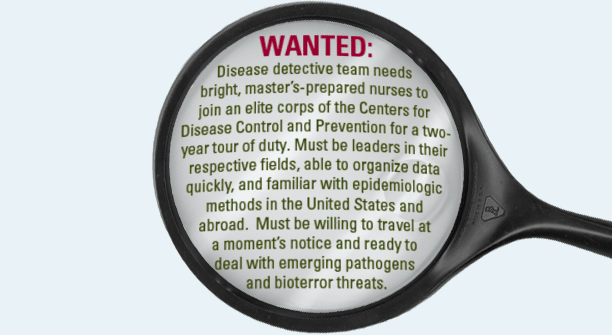 |
| |
|
|
| |
 t’s
a want ad that won’t appear in newspapers or professional
journals. But there is a job in an important but little-known division
of the Centers for Disease Control and Prevention that fits the
description. It’s known as the Epidemic Intelligence Service,
or EIS, and its officers track down and solve public health puzzles,
sometimes at risk to their own health. t’s
a want ad that won’t appear in newspapers or professional
journals. But there is a job in an important but little-known division
of the Centers for Disease Control and Prevention that fits the
description. It’s known as the Epidemic Intelligence Service,
or EIS, and its officers track down and solve public health puzzles,
sometimes at risk to their own health.
Operating quietly in the shadows of the
CDC since 1951, the EIS has trained more than 2,800 people, from
physicians to anthropologists to veterinarians. For the Emory nursing
graduates who are selected, it is a premiere training and service
assignment in the epidemiology field.
Master’s-prepared nurses—usually
with public health backgrounds—represent about 2% of the EIS.
Just 59 nurses have been selected during the program’s 54-year
history. Seven of them are graduates of the Nell Hodgson Woodruff
School of Nursing.
Some EIS officers have the luxury
of easing into their assignments, while others have no choice but
to hit the ground running. For Maryam Haddad, 01msn/MPH, Amy Parker
05MSN/MPH, and Jenny Williams, 96N, 01MSN/MPH, there was no honeymoon
period. Their first few months as EIS officers turned into a mad
dash against time. While all had extensive public health experience
overseas, their first major assignments involved them in major domestic
events: Williams in response to the events of 9/11 and its aftermath;
Haddad to ensuring public safety during the 2002 Olympic Winter
Games in Utah, and Parker to the devastation of Hurricane Katrina.
These assignments seemed eons away
from their regular duties. But then again, the flexibility and challenges
of the EIS are what attracted these nurses to the program in the
first place. |
|
| |
|
|
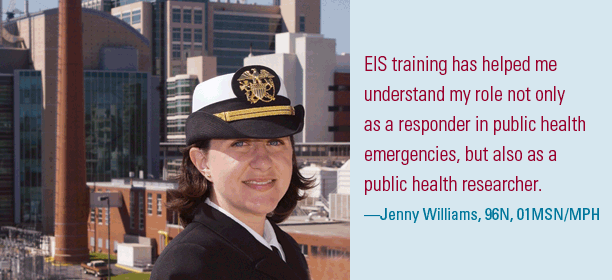 |
| |
|
|
| |
UNPRECEDENTED
TIMES |
|
| |
 hortly
after the attacks on the Word Trade Center in New York City, the
country was faced with another unprecedented public health emergency:
finding the source of the transmission of Bacillus anthracis—one
of the deadliest bacteria known to mankind. EIS teams were deployed
along the East Coast in response to the intentional release of anthrax
organisms through the U.S. mail. They needed to quickly identify
the source of transmission and protect the public from potential
exposure. hortly
after the attacks on the Word Trade Center in New York City, the
country was faced with another unprecedented public health emergency:
finding the source of the transmission of Bacillus anthracis—one
of the deadliest bacteria known to mankind. EIS teams were deployed
along the East Coast in response to the intentional release of anthrax
organisms through the U.S. mail. They needed to quickly identify
the source of transmission and protect the public from potential
exposure.
Williams was assigned with other EIS
officers to the Connecticut Anthrax Investigation Team, led by the
Connecticut Department of Public Health, to assist in their investigation
of an elderly Connecticut woman who had died of anthrax. It was
a particularly tense time for the country. No one knew exactly where
the threat lay.
“Fall 2001 was an unprecedented
time for the EIS and the CDC, and those events further underscore
the importance of having a public health infrastructure capable
of responding in times of crisis,” says Williams. “EIS
training has helped me understand my role not only as a responder
in public health emergencies but also as a public health researcher.”
She is now a nurse epidemiologist
with the CDC’s National Center on Birth Defects and Developmental
Disabilities (NCBDDD). “When I came to CDC, my background
was definitely not birth defects. I studied international health
and infectious disease,” says Williams, who completed her
EIS service in July 2003. But her EIS supervisor asked if she was
interested in pursuing the birth defects field, explaining that
during the two-year training program she would develop the needed
content expertise. “I was very pleasantly surprised at the
number of opportunities I had as an officer. NCBDDD not only has
given me a solid foundation in birth defects prevention but also
helped me diversify my public health experiences and increase my
involvement in international work.”
With the CDC, Williams has worked
on temporary assignments in Kabul, Afghanistan; Yei, Sudan; and
Sierra Leone. Most recently, she was a part of emergency hurricane
relief efforts providing nursing care to Hurricane Katrina victims
who had relocated to Arkansas.
Her current projects with NCBDDD focus
on neural tube defect prevention, understanding barriers to glycemic
control for women with diabetes in pregnancy, and developing an
online continuing education module on detection and treatment of
vitamin B12 deficiency for health care providers.
As a former EIS officer, Dr.
Stan Foster, professor of global health in the Rollins School of
Public Health at Emory and adviser to MSN/MPH students like Williams,
has seen major changes in who is selected for EIS.
“When I was part of the EIS
in 1962, it was almost all physicians and infectious disease and
98% male,” he says. “Now it’s practically the
reverse, with 80% to 90% female. EIS has a broader perspective,
bringing economists, anthropologists, and veterinarians into the
program.”
Dual master’s-prepared nurses
(in nursing and public health) make excellent EIS officers, and
Foster is constantly on the lookout for good candidates. “I
look for nurses with some international experience and who see their
future as making a difference with underserved populations at home
and abroad. Excellence in quantitative and interpersonal skills,
together with a track record of outstanding work in the field, alerts
me to their potential as future EIS officers.” Haddad, Parker,
and Williams all fit that bill, he adds. |
|
| |
|
|
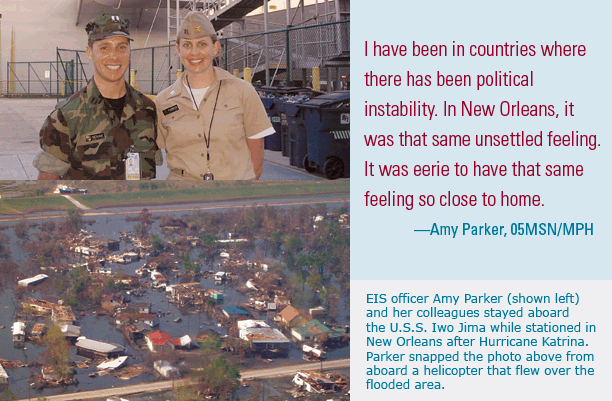 |
| Photographs
courtesy of Amy Parker |
|
| |
|
|
| |
‘YOU
SHOULD DO THAT’ |
|
| |
 ight
years ago, as a nurse working at the University of Wisconsin Hospital,
Amy Parker heard a physician friend regale her with tales of the
EIS. “I thought then it was exclusive to MDs and PhDs,”
she says. ight
years ago, as a nurse working at the University of Wisconsin Hospital,
Amy Parker heard a physician friend regale her with tales of the
EIS. “I thought then it was exclusive to MDs and PhDs,”
she says.
Two years after 9/11 and the subsequent
anthrax scare, Parker sat in a lecture hall, transfixed again by
the stories of the EIS—this time told by Williams, who was
a guest lecturer at a nursing event Parker attended. It was, as
they say, kismet.
“Many of my professors had connections
with the CDC, and a lot of Emory’s public health professors
were former EIS officers,” says Parker. “The first week
of grad school, Jenny Williams came back and gave a speech. She
had been in EIS for about a year at that point, and I was really
intrigued. I turned around and there was the dean [Dr. Marla Salmon]
sitting behind me. She said, ‘You should do that, Amy.’
From that point forward, I decided that it was something that nurses
could do and looked for classes that would give me a good foundation
in epidemiology.”
When Parker graduated from the MSN/MPH
program in international health last year, she was recruited to
EIS. Soon afterward, she faced a domestic challenge with her CDC
employer: traveling to New Orleans after Hurricane Katrina. While
pursuing her dual degree, she had collaborated with the CDC’s
Foodborne and Diarrheal Diseases branch and CARE-Kenya and taught
the CDC’s Safe Water System and hand washing to Kenyan nurses.
That knowledge base would serve her well on the Gulf Coast when
she was faced with deteriorating conditions after Hurricane Katrina.
“In my third week with EIS,
there was a measles outbreak in Indiana, and I went there to investigate
it further. Two weeks later, I was sent to New Orleans as part of
a team of 10,” says Parker.
The group was assigned to epidemiology
injury and illness surveillance in hospital emergency rooms and
at the makeshift Disaster Medical Assistance Team (DMAT) sites.
“Rumors of cholera were huge,” she says. “We were
tracking for injury and illness trends by gathering data from the
open ERs and from the DMATs and trying to determine if any outbreaks
were emerging. With these data we were able to help calm a lot of
fears and answer a lot of questions. What was detected was a strain
of Vibrio bacteria, but it wasn’t cholera. We did a lot of
public education.”
With no housing available on the ground,
the group stayed for two weeks aboard the U.S.S. Iwo Jima, a Navy
ship docked in New Orleans in the area known as Riverfront. “It
seemed so out of context, going back to the ship each day in this
area of the city that used to be so alive and touristy,” Parker
says. “Instead, we were walking through army tents and had
to go through military checkpoints to board the docking area. The
backdrop made it surreal.”
Given her sobering experiences in
developing countries, Parker still found it devastating to see the
Gulf Coast so ravaged.
“When we got down to New Orleans,
the city was empty, except for the relief workers and a handful
of people who never left. It was eerie, not seeing a single other
human being except for guys in Army fatigues, carrying huge M-16s.
I have been in countries where there has been political instability.
In New Orleans, it was that same unsettled feeling. It was eerie
to have that same feeling so close to home.”
Parker is nearing the end of her first
year as an EIS officer and enjoys listening to her classmates’
stories. “We’ve been really busy, and I just happened
to start with a bang. It’s interesting to talk to other classmates.
There is such a range of experiences. It depends on the area you’re
in. That’s the nature of EIS. There’s a lot of ebb and
flow.” |
|
| |
|
|
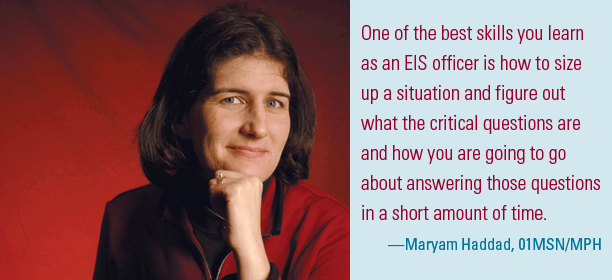 |
| |
|
|
| |
SIZING
UP A SITUATION |
|
| |
 he
changing nature of EIS work appeals to Parker and her Emory nursing
colleagues. Field experiences involving 16-hour days investigating
a viral strain may be followed by hours behind a desk, writing dispatches
for the CDC’s Morbidity and Mortality Weekly Report. he
changing nature of EIS work appeals to Parker and her Emory nursing
colleagues. Field experiences involving 16-hour days investigating
a viral strain may be followed by hours behind a desk, writing dispatches
for the CDC’s Morbidity and Mortality Weekly Report.
Maryam Haddad insists that a job with
the EIS “is not swooping in and saving the day,” as
the program is portrayed in Beating Back the Devil (Simon
& Schuster, 2004), the book by Maryn McKenna that explores the
world of disease detectives with the EIS.
Still, there have been plenty of challenges—both
in the field and behind the desk. When Haddad was stationed at the
Utah Department of Health, she assisted with bioterrorism surveillance
during the 2002 Olympic Winter Games in Salt Lake City, managing
the state public health surveillance team and monitoring ER visits
in the community and athlete illnesses in the Olympic Village. Today,
she is an EIS supervisor, helping train EIS officers in the CDC’s
Division of Tuberculosis Elimination.
Educated as a family nurse practitioner,
Haddad originally planned to work in chronic disease management
to care for patients with hypertension. But her interest in epidemiology
and travel made her open to other ideas, and she was recruited to
the EIS program. Her CV included working with Williams on a graduate
school project to evaluate a nurse education model for the Fiji
Islands. It wasn’t too much of a stretch to move toward public
health, and when the opportunity arose, she took it.
“I had always been fascinated
by the CDC,” she says. “In the 1980s, I remember reading
Time magazine articles about the CDC, and the idea of an
investigator going out and doing all this detective work to solve
a medical problem sounded so interesting. When I came to Atlanta
(for the MSN/MPH program at Emory), I realized a lot of professors
at Rollins worked at the CDC or with EIS.
“EIS is integrated throughout
the CDC,” she adds. “I am one of the many epidemiologists
across the agency helping EIS officers complete their two-year training
program.” In the process, she tries to pass on some of the
knowledge and insight she has gained.
“One of the best skills you
learn as an EIS officer is how to size up a situation and figure
out what the critical questions are and how you are going to go
about answering those questions in a short amount of time. This
has parallels to the nursing process and the quick thinking on your
feet that you have to do when you are managing a patient’s
care.”
In her role with tuberculosis surveillance,
Haddad looks at how TB spreads throughout a population or community.
“I look at how disease patterns move across a community or
in a population and try to make sense of it for what’s going
on in the environment,” she explains. “We’re not
just counting cases but also describing who gets the disease.”
An exciting development for Haddad
is the ability to see the genetic fingerprint of TB. “Nationally,
we began genotyping for every TB culture in 2004,” she says.
“TB strains have different genetic markers, and we’re
better able to understand TB transmission now that we have the technology
to look at different strains. For example, if I gave TB to you,
and you wound up sick, the DeKalb County Board of Health would know
that we had matching TB strains. Even if I hadn’t named you
as a contact, the health department could come back to us and try
to figure out the relationship. TB has a long incubation period
from the time you are infected to the time you get sick. When we
see the same strains over and over again, we can pinpoint the spread
better in less time.”
Although Haddad still goes out into
the field occasionally, she is more often behind a computer. That
kind of disease detective work also excites her. “I have always
loved math and computers and crunching numbers, and my work allows
me to do that.”
As Haddad and her fellow alumni attest,
the practical and long-term benefits of their service as EIS officers
can be measured, both in terms of networking and in developing professional
skills.
“There were so many doors
opened. It was such a wonderful opportunity to learn from really
great people,” Haddad says. “There’s something
to be said about a mentoring system that takes on young epidemiologists
and makes sure they get two great years of training. The network
it has created is unique.”
Rebecca
Rakoczy is an Atlanta freelance writer. |
|
| |
|
|
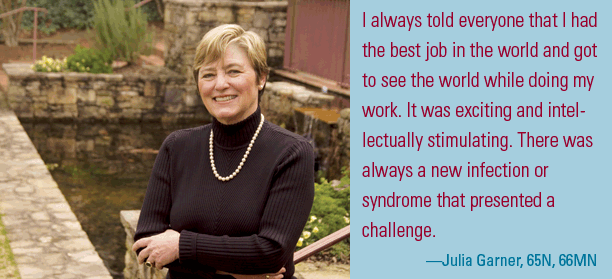 |
| |
|
|
| |
EIS
REGISTRY |
|
| |
|
|
| |
 o
date, seven School of Nursing alumni have served with the EIS, and
another will soon join the fold after Amy Valderrama, 01MSN, receives
her doctorate in nursing in May. She applied to the program to gain
postdoctoral research experience and combine her background as a
cardiovascular nurse with her interest in public health and epidemiology.
“The EIS program seemed a great match for me,” says
Valderrama, who begins her EIS training in July. o
date, seven School of Nursing alumni have served with the EIS, and
another will soon join the fold after Amy Valderrama, 01MSN, receives
her doctorate in nursing in May. She applied to the program to gain
postdoctoral research experience and combine her background as a
cardiovascular nurse with her interest in public health and epidemiology.
“The EIS program seemed a great match for me,” says
Valderrama, who begins her EIS training in July.
Like Amy Parker, who was inspired
by Emory nursing alumna Jenny Williams, Kirsten Ernst, 02MSN/MPH,
first heard about the EIS program thanks to alumna Maryam Haddad.
“Maryam and I had been friends—she
was a year ahead of me in the same dual-degree program and served
as a mentor to me,” says Ernst. “She also introduced
me to Jenny when they were both applying to the EIS program. I quickly
saw how exciting it was and what kind of potential it held.”
Accepted soon after graduating in
2002, Ernst’s EIS experience included investigating the West
Nile virus epidemic in Mississippi, being part of a health care
team monitoring adverse health events after smallpox vaccinations
of Atlanta civilians, and investigating concerns regarding an increase
in respiratory irritation (possibly due to a potential airborne
exposure in Ohio) with the Agency for Toxic Substances and Disease
Registry, a sister agency of the CDC.
After completing her EIS service,
Ernst, a family nurse practitioner, returned to patient care, working
with the chief of cardiology at St. Joseph’s Hospital in Atlanta.
She recently put nursing practice on hold to spend time with her
newborn daughter.
“One of the most notable things
I enjoyed about the EIS is that it’s such a dynamic environment
to be involved in,” says Ernst. “You are part of a diverse
group of individuals who have unique backgrounds, strengths, and
perspectives. Our class had doctors, PhDs, nurses, veterinarians,
dentists, and even a lawyer. It was very exciting to be part of
such an exemplary team.”
Family nurse practitioner Dawn Raymond,
89N, 93MSN, may be one of the few nurses without a public health
degree who was accepted into the EIS program.
“I guess I snuck under the radar,”
she says. “When I was working on my master’s degree
in nursing, I took some classes at the School of Public Health and
was exposed to EIS with officers presenting weekly seminars on the
latest outbreak. I thought it was really fascinating work. After
working as a nurse practitioner for a couple of years, I applied
and was accepted as part of the EIS class of 1999 to 2001.”
While in EIS, she served with the
National Immunization Program (NIP) in Atlanta. Her first assignment
was in Lansing, Michigan, as part of a national response to reports
of a potentially life-threatening form of bowel obstruction among
infants who received a newly licensed vaccine. She also worked as
a field supervisor in collaboration with the Chicago Department
of Health to determine the risk of a measles outbreak among preschool
children in a city neighborhood.
“There is a long matching process
when you get into the EIS program. I ended up being matched with
NIP, and it was a good fit,” Raymond notes. Today she is a
family nurse practitioner with a small private practice in North
Carolina.
Julia Garner, 65N, 66MN, has the distinction
of being the first School of Nursing graduate to join the EIS. “I
was young, good in math, and willing to travel,” Garner says
of her EIS experience from 1969 to 1971. In a program that was then
populated predominately by male physicians and PhDs, she was also
a trailblazer. “I tried to be a good role model,” she
adds. She was the only nurse—and woman—in a class of
46.
After finishing her master’s
degree in public health nursing, she was involved with the CDC,
writing courses for public health nurses in epidemiology and statistics.
“I was then invited by the head of the EIS to work on bacterial
diseases in hospitals.“
During her career, Garner worked with
the World Health Organization and traveled to Kuwait three times
as a consultant to the Ministry of Health during the 1980s. Her
specialty was hospital infection epidemics and nosocomial (hospital-acquired)
prevalence studies, and she wrote several studies on infection control.
“I always told everyone that I had the best job in the world
and got to see the world while doing my work. It was exciting and
intellectually stimulating. There was always a new infection or
syndrome that presented a challenge,” Garner says.
She retired from the CDC in 1997.
Among her many career awards is the CDC’s Hospital Infections
Program Lifetime Achievement Award for “significant contributions
to infection control, health care epidemiology, and patient protection.”—Rebecca
Rakoczy |
|
| |
|
|
| |
|
|
| |
|
|
|
|
|